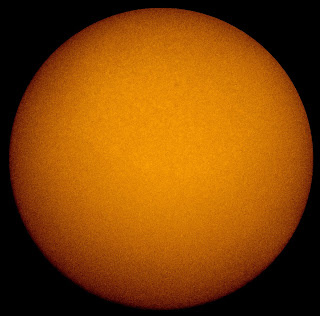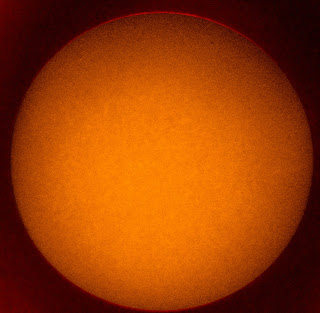March 29th 2215 GMT
I didn’t get outside until late and had an early start the
next day. I decided not to take a camera out and when I got outside I was glad
I didn’t bother. It was so hazy, especially near the horizon, that I could not
even see the Hyades and Pleaides (M45) in binoculars! I could see the brighter
stars of Melotte 20 and also the Beehive (M44), as it was higher in the sky. I
could also see Melotte 111, which had reached a respectable altitude. No other
deep sky objects, apart from Alcor/Mizar were visible, so that was that!
March 28th 2100 GMT
I went out with my DSLR, with my usual settings of 300mm
focal length. ISO 6400 and 2 seconds exposure.
First up was Melotte 20. Like the Beehive (M44), I find it
difficult to resist. I didn't catch it, though!
I had trouble finding M34, so I went for M35. Got this one!
I went back to M34 and missed it.
March 27th 1340 GMT
There was a patch of clear sky but the Sun was quiet. As
usual, I proceeded with a photo shoot anyway!
March 26th 2250 GMT
I would have gone out earlier, except my camera battery was
flat! Despite the weather forecast, it was surprisingly clear. Having possibly
caught Ursa Major the night before, I was hoping for some closer shots with my
DSLR at 300mm focal length, ISO6400 and 2 seconds exposure.
I started off by having another pop at Regulus. I was having
real trouble getting M35 and thought that it might be one of those nights.
I got a few quality frames of the Beehive (M44).
I had a few goes at M67 but did not think I had caught it,
despite taking several shots around the target area.
March 25th 2100 GMT
I was busy indoors, so set a camera to take star trail shots
of the Plough.
They were over-exposed. I took some stills and spent ages trying to stitch the whole constellation but it didn't work. I just caught the western part.
March 25th 1440 GMT
March 24th 2025 GMT
The clear sky continued past dusk and I wanted to revisit
some deep sky objects with my DSLR at 300mm focal length, ISO 6400 and 2
seconds exposure. Unfortunately, the focus was a bit off.
First up was the Pleaides (M45), mostly as a sighter.
More in hope than judgement I went for M65 and M66 in Leo. I didn't catch either.
I finished with the Tau Canis Majoris cluster. I missed the target.
March 24th 1050 GMT
There was a rare clear sky, I shot the Sun in hydrogen alpha
light using my PST. The solar disc seemed quiet.
March 23rd 0945 GMT
There were some sunspots on the Learmonth Solar Observatory images. Despite moving cloud, I tries to see them with my binoculars and filters but without success.
March 17th 2335 GMT
The sky was clear but it was cold and I felt too tired to
drag a telescope outside. I took some full disc solar shots with my DSLR at
300mm focal length, ISO 6400 and 1/4000 second focal length.
March 17th 1015 GMT
March 16th 2355 GMT
March 14th 1235 GMT
March 12th 2235
There was a rare patch of clear sky, so I “attacked” the
Moon with my DSLR at 300mm focal length, ISO 6400 and 1/4000 second exposure. Unfortunately, all attempts were ruined by poor focus.
March 11th 1010 GMT
March 10th 2330 GMT
March 10th 2035 GMT
The first shot was the Plough but I had to remove a lot of stray light.
I got my Perseus shot for a writing project but attempts to stack multiple images resulted in some stars appearing double. I processed a single frame that also included the Pleaides (M45).
I caught the Hyades and Pleaides in the same frame.
I took two frames of Cassiopeia but they didn't stack. I processed a single shot and caught the Perseus Double Cluster and Melotte 20 in the same frame.
March 10th 1835 GMT
March 10th 1215 GMT
I had been watching moving cloud, on and off, for a while
when I finally caught a clear spell and photographed the Sun. It was quiet in
hydrogen alpha light.

























